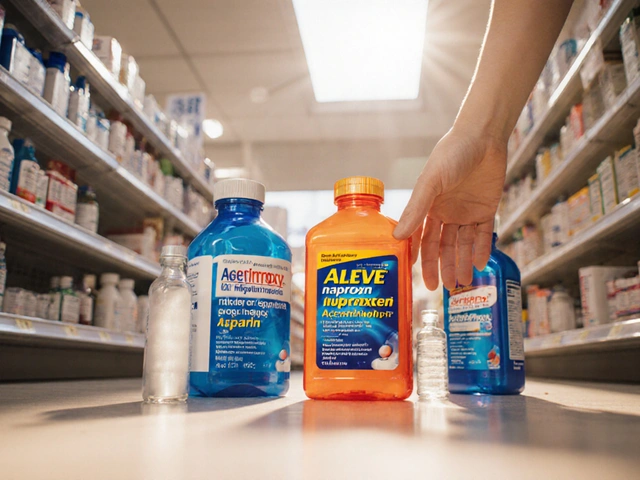Pain Relief Comparison Tool
Recommended Pain Relief Option:
Why This Choice:
Key Takeaways
- Aleve (naproxen) provides longer‑lasting relief than ibuprofen but has a higher GI‑risk profile.
- Ibuprofen is fast‑acting and works well for mild‑to‑moderate pain, especially for athletes.
- Acetaminophen is the safest choice for fever and headache when inflammation isn’t the main issue.
- Aspirin adds antiplatelet benefits but can irritate the stomach at regular doses.
- Prescription NSAIDs like diclofenac or meloxicam are options for chronic joint pain, but they require medical supervision.
When you reach for an over‑the‑counter pain reliever, the brand name often hides a generic ingredient with its own strengths and quirks. Aleve is the brand name for naproxen, a non‑steroidal anti‑inflammatory drug (NSAID) that reduces pain, fever, and inflammation. Understanding how naproxen stacks up against other common options helps you pick the right pill for the right situation.
How Aleve (naproxen) Works
Naproxen blocks the cyclooxygenase enzymes COX‑1 and COX‑2, which are key players in producing prostaglandins - the chemicals that cause swelling and pain. Because it stays in the bloodstream for about 12‑15 hours, a single 220mg tablet can cover a full day of aches, making it popular for back pain, menstrual cramps, and arthritis.
What to Compare: Decision Criteria
Before diving into the side‑by‑side table, think about the factors that matter most to you:
- Duration of relief - how long each dose lasts.
- Speed of onset - how quickly you feel better.
- Inflammatory power - ability to reduce swelling.
- Stomach safety - risk of GI irritation or ulcers.
- Heat‑related risks - effect on blood pressure and cardiovascular health.
- Cost and accessibility - price per dose and whether a prescription is needed.
- Special considerations - allergies, pregnancy, or chronic conditions.

Side‑by‑Side Comparison
| Attribute | Aleve (naproxen) | Ibuprofen | Acetaminophen | Aspirin | Diclofenac | Meloxicam |
|---|---|---|---|---|---|---|
| Typical OTC dose | 220mg every 8‑12h (max 660mg/day) | 200‑400mg every 4‑6h (max 1200mg/day OTC) | 500‑1000mg every 4‑6h (max 3000mg/day) | 325‑650mg every 4‑6h (max 4g/day) | Prescription 25‑50mg twice daily | Prescription 7.5‑15mg once daily |
| Time to onset | 30-60min | 20-40min | 30-60min | 45-60min | 30-45min | 30-45min |
| Duration of relief | 8‑12h (up to 15h) | 4‑6h | 4‑6h | 4‑6h | 6‑8h | 12‑24h |
| Anti‑inflammatory strength | High (COX‑1&COX‑2) | Moderate (COX‑2 biased) | None (analgesic only) | Low‑moderate | High (COX‑2 selective) | High (COX‑2 selective) |
| Gastro‑intestinal risk | Moderate‑high (ulcer risk ↑ with long use) | Low‑moderate (dose‑dependent) | Very low | Moderate (especially >325mg) | High (requires GI protection) | Moderate‑high (monitor GI) |
| Cardiovascular cautions | Potential ↑ risk with chronic high dose | Similar caution at high dose | Neutral | Low dose may be cardioprotective; high dose ↑ risk | Higher CV risk; avoid in heart disease | Lower CV risk than non‑selective NSAIDs |
| Pregnancy category | Category C (avoid 3rd trimester) | Category C (avoid 3rd trimester) | Category B (generally safe) | Category D (avoid after 20wks) | Category C (prescription only) | Category C (prescription only) |
| Typical price (USD) | $0.15‑$0.30 per tablet | $0.10‑$0.25 per tablet | $0.08‑$0.20 per tablet | $0.12‑$0.25 per tablet | $1.00‑$2.50 per tablet (prescription) | $1.20‑$3.00 per tablet (prescription) |
When Aleve (naproxen) Is the Right Choice
If you need all‑day pain control without re‑dosing, naproxen shines. It’s especially useful for:
- Menstrual cramps that last more than a few hours.
- Back or joint pain that flares overnight.
- Inflammatory conditions like mild osteoarthritis where daily dosing is acceptable.
Just watch the stomach. Taking Aleve with food, limiting alcohol, and avoiding other NSAIDs reduces ulcer risk.
When an Alternative Beats Aleve
Not every ache is an inflammation‑driven one. Here’s when you might reach for something else:
- Fever or tension headache - acetaminophen works fast, spares the stomach, and is safe for most adults.
- Quick sports‑related strain - ibuprofen’s rapid onset and moderate inflammation control fit well.
- Cardiovascular or bleeding concerns - low‑dose aspirin can add heart‑protective benefits, but only under doctor guidance.
- Chronic arthritis needing prescription strength - diclofenac or meloxicam give stronger, longer relief but demand monitoring.

Safety Tips and Interaction Alerts
All NSAIDs share a core warning: they can irritate the lining of the stomach and affect kidney function. Keep these habits in mind:
- Never double‑dip - avoid taking naproxen together with ibuprofen, aspirin, or prescription NSAIDs.
- Check blood‑pressure meds. Certain antihypertensives (e.g., ACE inhibitors) can have reduced effectiveness when paired with NSAIDs.
- Stay hydrated. Dehydration raises the risk of kidney injury, especially in older adults.
- If you have a history of ulcers, talk to a pharmacist about adding a proton‑pump inhibitor (PPI) when using Aleve.
Buying Guide: What to Look For
When you shop, consider these practical points:
- Packaging size - larger bottles lower the per‑tablet cost but check the expiration date.
- Generic vs brand - the active ingredient is the same; generic naproxen often saves 30‑50%.
- Retail vs online pharmacy - reputable online stores may offer subscription discounts, but verify they require a prescription for higher‑strength formulations.
- Return policy - some brick‑and‑mortar pharmacies allow returns if you’re not satisfied.
Bottom Line
Choosing the best OTC pain reliever comes down to three questions: Is inflammation the main problem? How long do you need relief? and What’s your stomach‑health status? Aleve (naproxen) scores high on duration and anti‑inflammatory power, but it asks for extra stomach protection. Ibuprofen offers a faster kick with moderate duration; acetaminophen is the safest for pure pain or fever; aspirin adds a cardio‑protective twist; and prescription NSAIDs like diclofenac or meloxicam are reserved for persistent joint pain under a doctor’s watch.
Frequently Asked Questions
Can I take Aleve together with ibuprofen for extra pain relief?
No. Combining two NSAIDs increases the risk of stomach ulcers, kidney strain, and cardiovascular side effects. Choose one NSAID and stick with it, or alternate with a non‑NSAID like acetaminophen if you need extra coverage.
Is naproxen safe during pregnancy?
Naproxen is classified as Category C, meaning it should be avoided especially in the third trimester. If you need pain relief while pregnant, acetaminophen is generally preferred after consulting your obstetrician.
Which OTC option works best for migraine headaches?
Migraines often respond best to a combination of a fast‑acting NSAID (like ibuprofen 400mg) plus a triptan if prescribed. Acetaminophen alone is less effective unless combined with caffeine.
How often can I safely take Aleve for chronic back pain?
The OTC limit is 660mg per day (three 220mg tablets). For chronic use, limit treatment to the shortest duration possible-usually no more than 10 days-unless a doctor advises otherwise.
Do I need to take Aleve with food?
Yes. Taking naproxen with a meal or a glass of milk helps cushion the stomach lining and reduces the chance of irritation.







Dean Briggs
When you dive into the labyrinth of over‑the‑counter analgesics, you quickly realize that each compound carries its own philosophical baggage, a testament to the intricate dance between efficacy and safety; Aleve, with its naproxen core, epitomizes the notion of longevity, offering eight to twelve hours of anti‑inflammatory relief that can span an entire workday, thereby reducing the cognitive load of remembering to re‑dose; yet this very persistence invites a higher gastrointestinal risk, a reminder that the body's mucosal defenses are not infinitely resilient, especially when other NSAIDs crowd the metabolic pathways; the user must therefore contemplate the trade‑off between sustained pain control and the potential for ulcer formation, a dilemma that has haunted clinicians since the dawn of modern pharmaco‑therapy; additionally, naproxen's dual COX‑1 and COX‑2 inhibition grants it a potent anti‑inflammatory profile, making it a go‑to for conditions like arthritis, whereas ibuprofen's more COX‑2‑biased action renders it a faster, albeit shorter, solution for acute injuries; the cardiovascular considerations add another layer of nuance, as chronic high‑dose naproxen may nudge the risk profile upward, demanding vigilance from those with existing heart disease; the pharmacokinetic footprint of naproxen, lingering for up to fifteen hours, also influences patient compliance, often translating to fewer pills swallowed and a more straightforward regimen; nevertheless, the importance of co‑administration with food cannot be overstated, as this simple act can mitigate gastric irritation and preserve the therapeutic window; one must also weigh the socioeconomic aspect, where generic naproxen can be sourced at a modest price, offering accessibility without compromising on potency; the interplay between renal function and NSAID use further complicates the picture, especially in older adults whose glomerular filtration rates may be compromised, necessitating dose adjustments or alternative agents; ultimately, the decision matrix hinges on three pivotal questions: Is inflammation the primary driver? How long must relief last? And what is the individual's gastrointestinal and cardiovascular health status? By rigorously interrogating these variables, the clinician or informed consumer can arrive at an evidence‑based choice that aligns with personal health goals and risk tolerance, embodying the very spirit of personalized medicine.
Sadie Speid
Great breakdown! The comparison chart makes it super easy to see why Aleve shines for long‑lasting pain. I love how you highlighted the importance of taking it with food – that’s a game‑changer for my stomach.
Sue Ross
This is exactly the kind of balanced overview we need. You covered the duration, onset, and safety aspects without bias. It helps readers match their specific condition-like chronic joint pain versus a sudden headache-to the right OTC option. I especially appreciate the reminder about kidney health for older adults.
Rohinii Pradhan
While the article is thorough, it omits a critical point regarding drug‑drug interactions: naproxen can attenuate the antihypertensive effect of ACE inhibitors, a nuance that clinicians must heed. Moreover, the statement that naproxen is "Category C" during pregnancy lacks the clarification that third‑trimester exposure is particularly contraindicated due to potential premature closure of the ductus arteriosus. The inclusion of this data would elevate the piece from merely informative to truly comprehensive.
Anna-Lisa Hagley
The chart is useful, but remember that "low‑moderate" GI risk still means ulcer vigilance for anyone with a history of gastritis. Consider adding a note about proton‑pump inhibitors as prophylaxis.
A Walton Smith
Not worth it.
Theunis Oliphant
One must not fall prey to the allure of convenience at the expense of physiological harmony. The unwary consumer, enamored by the promise of a single dose lasting an entire day, may neglect the silent peril of gastrointestinal erosion that accompanies chronic NSAID usage. Such negligence is tantamount to intellectual complacency.
India Digerida Para Occidente
I appreciate the cautionary tone, but let’s keep the conversation constructive. While Aleve does carry GI risks, proper dosing and food intake can mitigate many of those concerns. For patients with chronic inflammatory conditions, the benefit often outweighs the potential downsides, especially when alternative therapies are limited.
Andrew Stevenson
From a pharmacokinetic standpoint, naproxen's half‑life offers a distinct advantage for maintenance therapy in osteoarthritis. However, clinicians should assess renal function before recommending daily use, as NSAIDs can precipitate acute kidney injury in susceptible populations. Moreover, combination therapy-pairing a low‑dose NSAID with a gastro‑protective agent-can optimize the risk‑benefit ratio. For patients on antihypertensives, monitor blood pressure closely, given NSAIDs’ potential to blunt antihypertensive efficacy. Lastly, patient education on signs of GI bleeding remains paramount.
Kate Taylor
Excellent points, especially the emphasis on renal monitoring. I’d add that patients should be counseled to avoid alcohol while on naproxen to further protect the stomach lining.
Hannah Mae
Honestly, I think people over‑think this stuff. Just pop a cheap Tylenol for a headache, you’re fine.
Iván Cañas
While acetaminophen is safe for many, it’s important to watch total daily dosage to avoid hepatic injury. For those with liver concerns, a low‑dose NSAID with food can be a better alternative.
Jen Basay
Thanks for the thorough rundown! :)
It really helps to see the pros and cons side by side.
Looking forward to trying the recommendation.
Hannah M
Glad you found it useful! 😊
Feel free to drop any follow‑up questions you might have.
Happy healing!
Poorni Joth
Stop pushing naproxen like its the holy grail! It can cause serious heart probs, and you cant just tell everyone to take it without a doc's ok.
People need real warnings, not sugar‑coated "it works".
Yareli Gonzalez
Valid concerns-risk communication is key. Encouraging readers to consult their healthcare provider ensures safe usage.